Unit 10 Wind 教案(3个课时)
文档属性
| 名称 | Unit 10 Wind 教案(3个课时) | 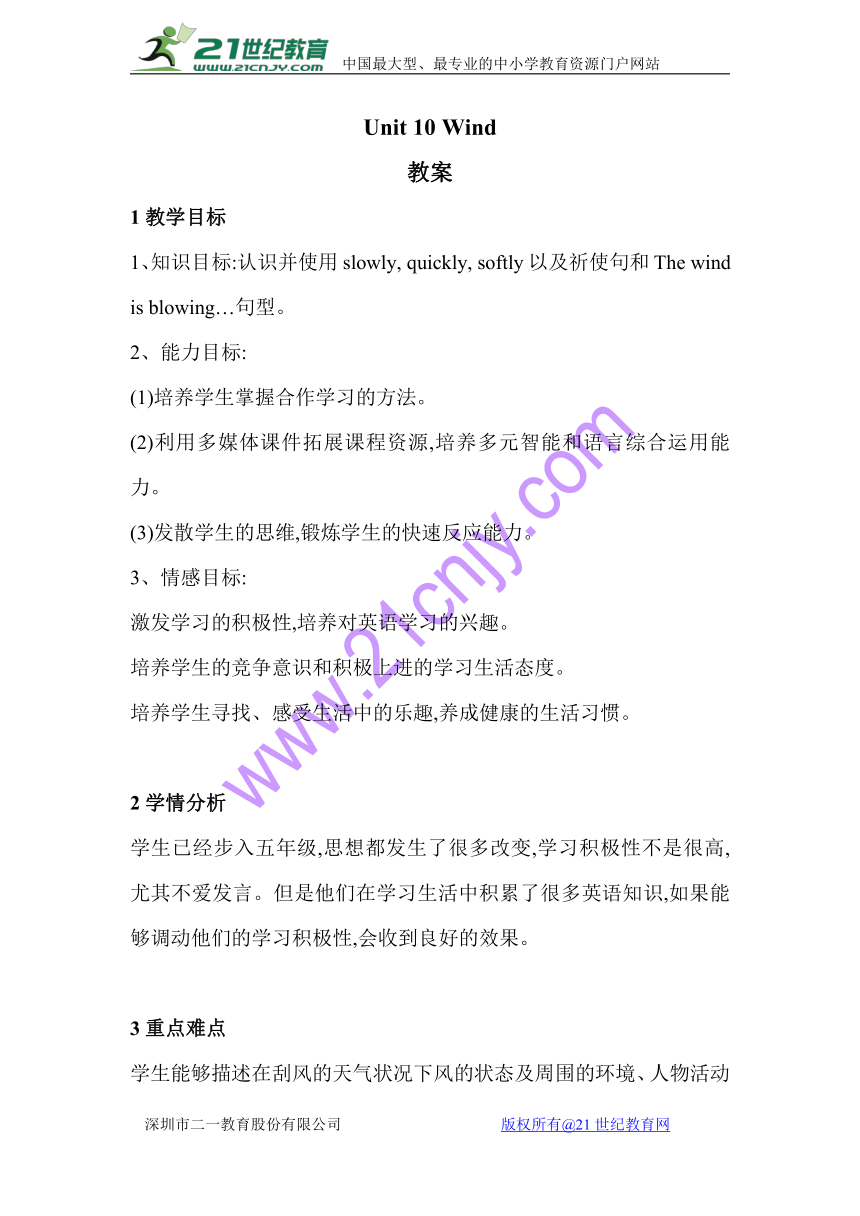 | |
| 格式 | zip | ||
| 文件大小 | 122.4KB | ||
| 资源类型 | 教案 | ||
| 版本资源 | 牛津沪教版 | ||
| 科目 | 英语 | ||
| 更新时间 | 2017-06-10 18:55:38 | ||
图片预览

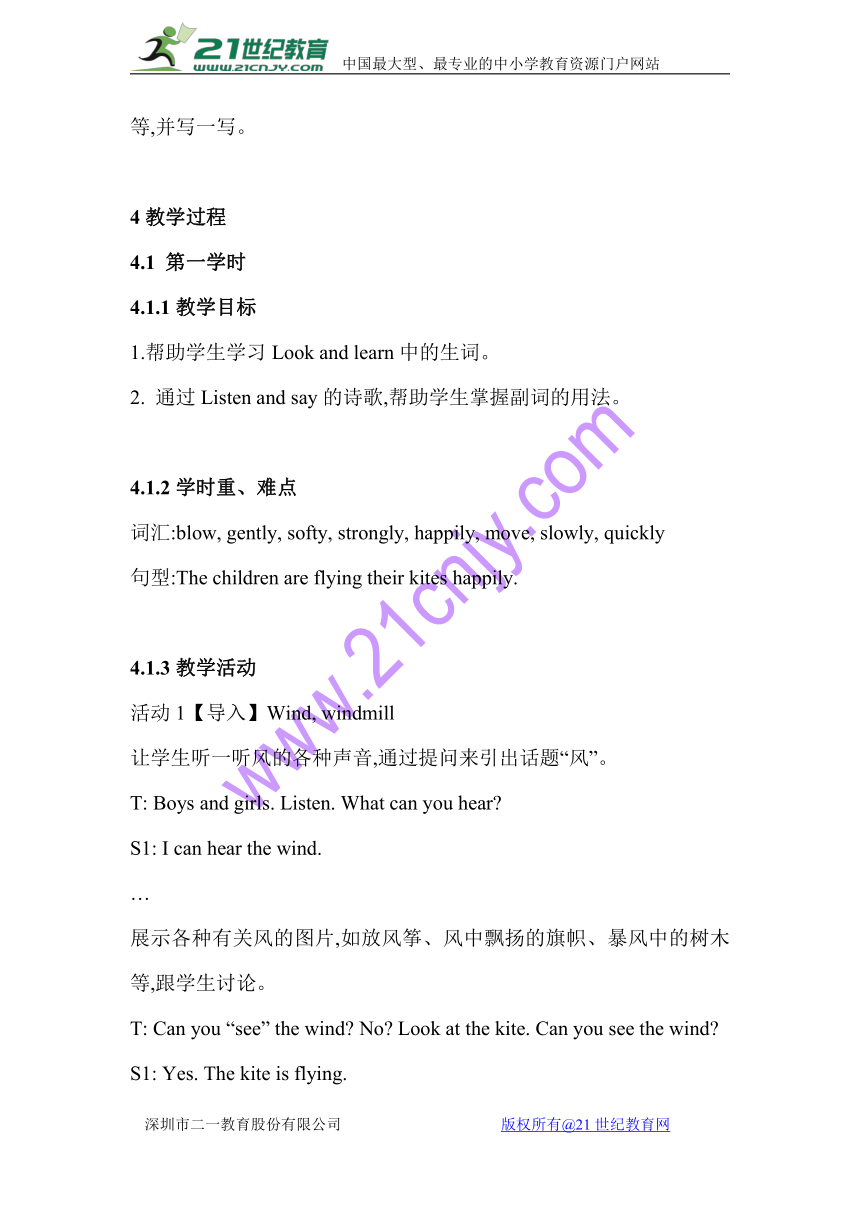
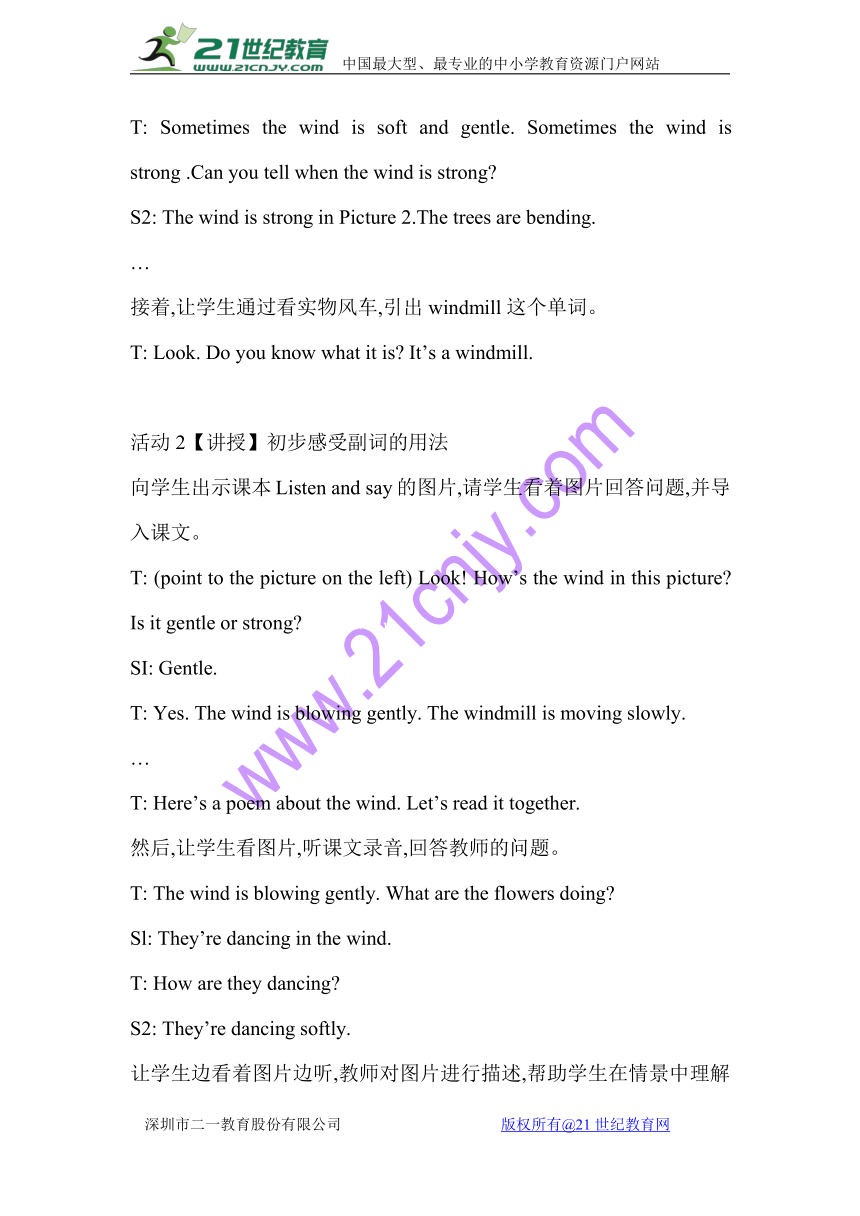
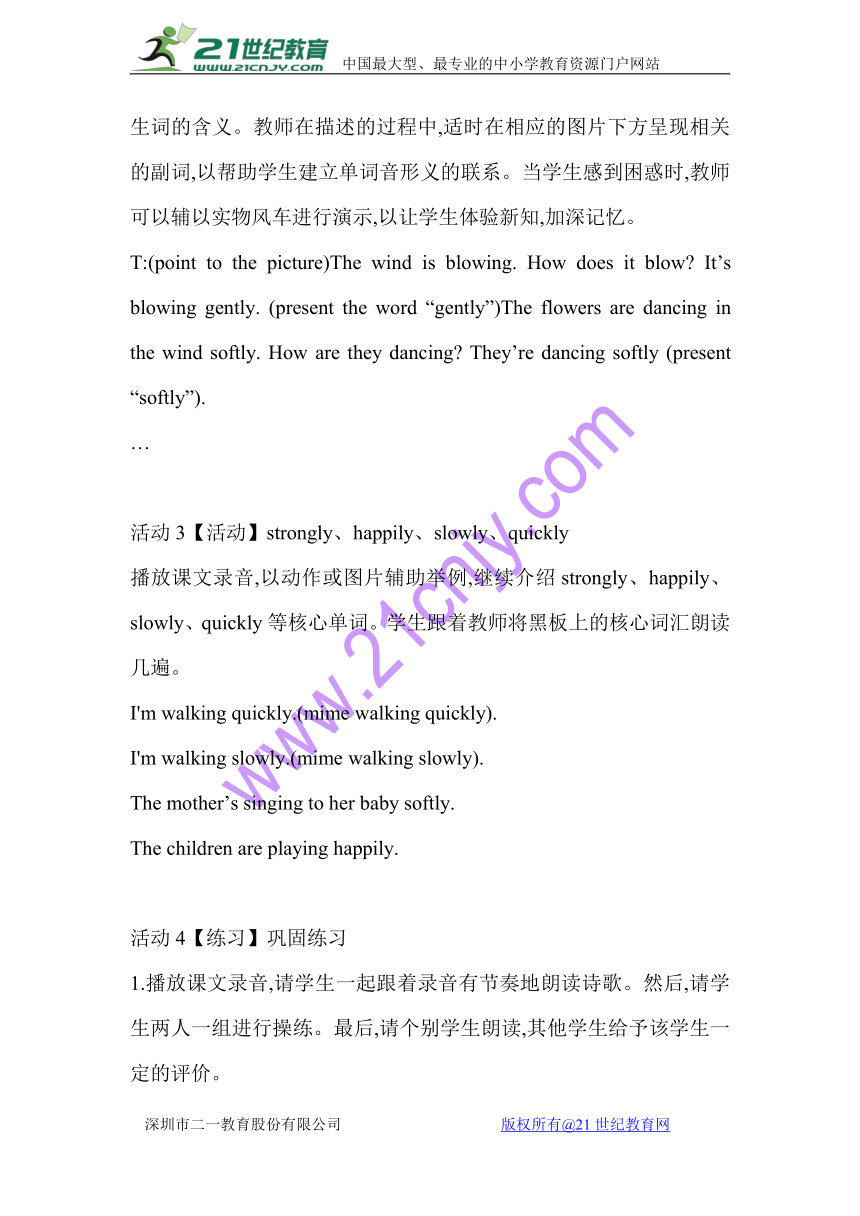
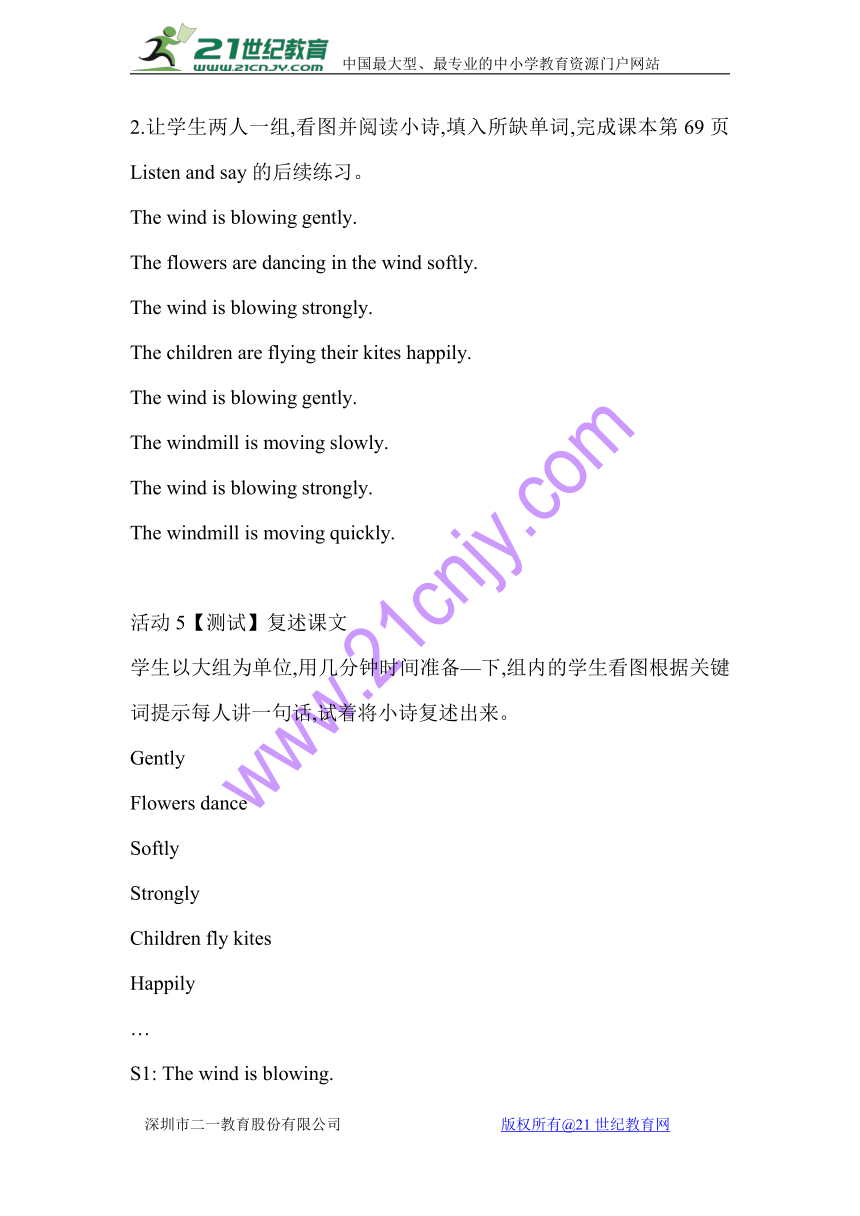
文档简介
Unit 10 Wind
教案
1教学目标
1、知识目标:认识并使用slowly, quickly, softly以及祈使句和The wind is blowing…句型。
2、能力目标:
(1)培养学生掌握合作学习的方法。 (2)利用多媒体课件拓展课程资源,培养多元智能和语言综合运用能力。 (3)发散学生的思维,锻炼学生的快速反应能力。
3、情感目标:
激发学习的积极性,培养对英语学习的兴趣。 培养学生的竞争意识和积极上进的学习生活态度。
培养学生寻找、感受生活中的乐趣,养成健康的生活习惯。
2学情分析
学生已经步入五年级,思想都发生了很多改变,学习积极性不是很高,尤其不爱发言。但是他们在学习生活中积累了很多英语知识,如果能够调动他们的学习积极性,会收到良好的效果。
3重点难点
学生能够描述在刮风的天气状况下风的状态及周围的环境、人物活动等,并写一写。
4教学过程
4.1 第一学时
4.1.1教学目标
1.帮助学生学习Look and learn中的生词。
2. 通过Listen and say的诗歌,帮助学生掌握副词的用法。
4.1.2学时重、难点
词汇:blow, gently, softy, strongly, happily, move, slowly, quickly
句型:The children are flying their kites happily.
4.1.3教学活动
活动1【导入】Wind, windmill
让学生听一听风的各种声音,通过提问来引出话题“风”。
T: Boys and girls. Listen. What can you hear?
S1: I can hear the wind.
…
展示各种有关风的图片,如放风筝、风中飘扬的旗帜、暴风中的树木等,跟学生讨论。
T: Can you “see” the wind? No? Look at the kite. Can you see the wind?
S1: Yes. The kite is flying.
T: Sometimes the wind is soft and gentle. Sometimes the wind is strong .Can you tell when the wind is strong?21教育名师原创作品
S2: The wind is strong in Picture 2.The trees are bending.
…
接着,让学生通过看实物风车,引出windmill这个单词。
T: Look. Do you know what it is? It’s a windmill.
活动2【讲授】初步感受副词的用法
向学生出示课本Listen and say的图片,请学生看着图片回答问题,并导入课文。
T: (point to the picture on the left) Look! How’s the wind in this picture? Is it gentle or strong?【版权所有:21教育】
SI: Gentle.
T: Yes. The wind is blowing gently. The windmill is moving slowly.
…
T: Here’s a poem about the wind. Let’s read it together.
然后,让学生看图片,听课文录音,回答教师的问题。
T: The wind is blowing gently. What are the flowers doing?
Sl: They’re dancing in the wind.
T: How are they dancing?
S2: They’re dancing softly.
让学生边看着图片边听,教师对图片进行描述,帮助学生在情景中理解生词的含义。教师在描述的过程中,适时在相应的图片下方呈现相关的副词,以帮助学生建立单词音形义的联系。当学生感到困惑时,教师可以辅以实物风车进行演示,以让学生体验新知,加深记忆。
T:(point to the picture)The wind is blowing. How does it blow? It’s blowing gently. (present the word “gently”)The flowers are dancing in the wind softly. How are they dancing? They’re dancing softly (present “softly”).【出处:21教育名师】
…
活动3【活动】strongly、happily、slowly、quickly
播放课文录音,以动作或图片辅助举例,继续介绍strongly、happily、slowly、quickly等核心单词。学生跟着教师将黑板上的核心词汇朗读几遍。
I'm walking quickly.(mime walking quickly).
I'm walking slowly.(mime walking slowly).
The mother’s singing to her baby softly.
The children are playing happily.
活动4【练习】巩固练习
1.播放课文录音,请学生一起跟着录音有节奏地朗读诗歌。然后,请学生两人一组进行操练。最后,请个别学生朗读,其他学生给予该学生一定的评价。www.21-cn-jy.com
2.让学生两人一组,看图并阅读小诗,填入所缺单词,完成课本第69页Listen and say的后续练习。
The wind is blowing gently.
The flowers are dancing in the wind softly.
The wind is blowing strongly.
The children are flying their kites happily.
The wind is blowing gently.
The windmill is moving slowly.
The wind is blowing strongly.
The windmill is moving quickly.
活动5【测试】复述课文
学生以大组为单位,用几分钟时间准备—下,组内的学生看图根据关键词提示每人讲一句话,试着将小诗复述出来。
Gently
Flowers dance
Softly
Strongly
Children fly kites
Happily
…
S1: The wind is blowing.
S2: It is blowing gently.
S3: The flowers are dancing in the wind softly.
S4: The wind is blowing.
S5: It is blowing strongly.
S6: The children are flying their kites happily.
…
接着,请个别学生试着看图背诵。
活动6【作业】Homework
试着用学到的副词造句子,并在小组内交流。
4.2 第二学时
4.2.1教学目标
1.通过Make and say及Draw and write的练习活动,帮助学生巩固本单元的生词及句型。21·世纪*教育网
2.帮助学生学习字母组合sc及sk在单词中的发音。
4.2.2学时重、难点
语音:sc(scarf),sk(skateboard)
4.2.3教学活动
活动1【导入】引出Make and say的内容
给学生出示一个风车,并进行问答,以引出Make and say的内容。
T: What is it?
S1: It’s a windmill.
T: Right. I can make a windmill. It can move. Do you want to make one?
Ss: Yes
活动2【讲授】Make and say
1.让学生看课本第72页Make and say的图片并阅读文字,然后回答教师的问题,教师可以在学生回答的同时出示相关实物。
T: What do we need?
S1: We need a pencil and some paper.
S2: We need a pair of scissors.
…
2.接着,请学生用课前准备的材料根据图片提示动手制作一个风车。然后说一说。
S1:(blow the windmill gently)The wind is blowing gently. My windmill is moving slowly.21教育网
S2:(blow the windmill strongly)The wind is blowing strongly. My windmill is moving quickly.2-1-c-n-j-y
活动3【活动】问答互动
请学生就课本第73页Draw and write栏目的图片,来回答教师的问题。
T: (point to the picture) Is the wind blowing strongly?【来源:21cnj*y.co*m】
S1:No.It’s blowing gently.
T: How are the leaves dancing?
S2: They’re dancing softly.
T: What’s the girl doing?
S3: The girl is singing happily.
继续出示有关风中景物的图片,如高高飞翔的风筝、快速飘动的云、跳舞的女孩、转动的风车等。鼓励学生仿照第一段口头说一说。学生可以小组或对子讨论。
S: The wind is blowing.
It’s blowing strongly.
The clouds are moving quickly.
然后,请学生完成该栏目的写作练习。邀请一些同学展示—下写作的作品。
活动4【练习】Learn the sounds
出示Learn the sounds的语音单词卡片sc(scarf)和sk(skateboard),请学生跟读单词并感知sc和sk在单词中的发音。21*cnjy*com
T:sc,/sk/,scarf,scarf;
Ss: sc,/sk/,scarf, scarf.
T: sk,/sk/,skateboard, skateboard;
Ss: sk,/sk/,skateboard, skateboard.
然后,教师播放Learn the sounds的儿歌录音,请学生模仿录音朗读儿歌。鼓励学生模仿录音中的语音语调。
告诉学生sc和sk的发音是相同的,都念/sk/,让他们想出尽可能多的词,并进行分类。
sc: scared, school, scream, Scotland
sk: ski, skip, skate, sky
活动5【测试】在风力不同的情况下人们能做什么?不能做什么?
把全班分成两大组,让学生在各自组中进行交流:在风力不同的情况下人们能做什么?不能做什么?
Group l
The wind is blowing gently.
People can go to the park.
They can’t fly kites.
…
Group 2
The wind is blowing strongly.
People can fly kites.
They can’t dry the clothes outside.
…
然后,让两组学生之间互相问答。
S1: The wind is blowing strongly. What can/can’t people do?
S2: People can fly kites in the sky.
They can’t dry the clothes outside.
活动6【作业】Homework
请学生以My windmill为题,写一段话,并将自己写的语段与同学交换,互相阅读。
Eg. This is my windmill. It is brown the wind is blowing strongly. My windmill is moving quickly.21·cn·jy·com
4.3 第三学时
4.3.1教学目标
1让学生阅读故事《风的声音》,通过看图回答问题、完成后续练习等阅读反馈活动,引导学生抓住关键信息,了解故事大意。
2通过学习任务(Task),帮助学生巩固和综合运用本单元所学的知识和技能。
4.3.2学时重、难点
词汇:sound, paper, quiet
日常用语:Me too. Why?
4.3.3教学活动
活动1【导入】Wind
向学生展示风铃,或以多媒体展示风铃的照片。
T: I have this by my window. When it moves, I know there’s wind. It makes beautiful sounds. When it makes a sound, I know there’s wind. It is a wind-bell.【来源:21·世纪·教育·网】
When my wind-bell is singing softly, I know the wind is blowing…
Ss: Gently.
T: Yes. When my wind-bell is singing loudly, I know the wind is blowing…www-2-1-cnjy-com
Ss: Strongly!
活动2【讲授】通过问答活动,了解故事大意。
向学生出示课本Read a story栏目的图片1,让学生根据图片及文字的内容回答问题。
T: (present Picture 1) Who is she?
S1: Little Duck.
T: What does she have?
S2: A glass wind-bell.
T: Where is Little Duck’s wind-bell?
S3: On her window.
T: The wind is blowing. What does she hear? How is the sound?
S4: She hears the sound of the wind/wind-bell. It sounds “tink-tink”
…
然后,请学生阅读课文并回答问题。
Picture 2
1) Where is Little Rabbit’s wind-bell? (In her room.)21世纪教育网版权所有
2) Does she like the sound of her wind-bell? (Yes, she does.)
3) What is like music? (The sound of Little Duck’s wind-bell. / The sound of the wind.)2·1·c·n·j·y
Picture 3
Who wants to hear the sound of the wind too? (Little Pig.)
Picture 4
What does Little Pig use to make his wind-bell? (Paper.)
Picture 5
1) Why doesn’t Little Pig like the sound of the wind? (Because it's too quiet.)21*cnjy*com
2) Why is Little Pig’s wind-bell too quiet? (Because paper cannot make a loud sound.)
活动3【活动】请学生为故事编一个结尾
1.播放课文录音,学生跟着录音朗读课文。然后完成下面的配对练习。
Little Rabbit’s wind-bell Tink-tink
Little Duck’s wind-bell Clink-clink
Little Pig’s wind-bell …
2.请学生帮助Little Pig,告诉他制作一个风铃合适的材料。请学生为故事编一个结尾。
T: Can you help Little Pig? What can he do?
Ss: He can use other things to make a wind-bell.
T: Yes, he can use wood, glass, or other things to make loud sounds.
…
活动4【练习】后续练习
在教师的指导下,学生完成课本第71页Read a story的后续练习。
最后总结新风铃的材料和声音。
T: Little Pig makes another wind-bell. It’s made of wood. He puts it on his window. Now the wind is blowing gently. His wind-bell sounds nice “Clack-clack”!21cnjy.com
活动5【作业】Homework
安排学生把整个故事编成剧本,安排角色,让学生分组演出课本剧。
教案
1教学目标
1、知识目标:认识并使用slowly, quickly, softly以及祈使句和The wind is blowing…句型。
2、能力目标:
(1)培养学生掌握合作学习的方法。 (2)利用多媒体课件拓展课程资源,培养多元智能和语言综合运用能力。 (3)发散学生的思维,锻炼学生的快速反应能力。
3、情感目标:
激发学习的积极性,培养对英语学习的兴趣。 培养学生的竞争意识和积极上进的学习生活态度。
培养学生寻找、感受生活中的乐趣,养成健康的生活习惯。
2学情分析
学生已经步入五年级,思想都发生了很多改变,学习积极性不是很高,尤其不爱发言。但是他们在学习生活中积累了很多英语知识,如果能够调动他们的学习积极性,会收到良好的效果。
3重点难点
学生能够描述在刮风的天气状况下风的状态及周围的环境、人物活动等,并写一写。
4教学过程
4.1 第一学时
4.1.1教学目标
1.帮助学生学习Look and learn中的生词。
2. 通过Listen and say的诗歌,帮助学生掌握副词的用法。
4.1.2学时重、难点
词汇:blow, gently, softy, strongly, happily, move, slowly, quickly
句型:The children are flying their kites happily.
4.1.3教学活动
活动1【导入】Wind, windmill
让学生听一听风的各种声音,通过提问来引出话题“风”。
T: Boys and girls. Listen. What can you hear?
S1: I can hear the wind.
…
展示各种有关风的图片,如放风筝、风中飘扬的旗帜、暴风中的树木等,跟学生讨论。
T: Can you “see” the wind? No? Look at the kite. Can you see the wind?
S1: Yes. The kite is flying.
T: Sometimes the wind is soft and gentle. Sometimes the wind is strong .Can you tell when the wind is strong?21教育名师原创作品
S2: The wind is strong in Picture 2.The trees are bending.
…
接着,让学生通过看实物风车,引出windmill这个单词。
T: Look. Do you know what it is? It’s a windmill.
活动2【讲授】初步感受副词的用法
向学生出示课本Listen and say的图片,请学生看着图片回答问题,并导入课文。
T: (point to the picture on the left) Look! How’s the wind in this picture? Is it gentle or strong?【版权所有:21教育】
SI: Gentle.
T: Yes. The wind is blowing gently. The windmill is moving slowly.
…
T: Here’s a poem about the wind. Let’s read it together.
然后,让学生看图片,听课文录音,回答教师的问题。
T: The wind is blowing gently. What are the flowers doing?
Sl: They’re dancing in the wind.
T: How are they dancing?
S2: They’re dancing softly.
让学生边看着图片边听,教师对图片进行描述,帮助学生在情景中理解生词的含义。教师在描述的过程中,适时在相应的图片下方呈现相关的副词,以帮助学生建立单词音形义的联系。当学生感到困惑时,教师可以辅以实物风车进行演示,以让学生体验新知,加深记忆。
T:(point to the picture)The wind is blowing. How does it blow? It’s blowing gently. (present the word “gently”)The flowers are dancing in the wind softly. How are they dancing? They’re dancing softly (present “softly”).【出处:21教育名师】
…
活动3【活动】strongly、happily、slowly、quickly
播放课文录音,以动作或图片辅助举例,继续介绍strongly、happily、slowly、quickly等核心单词。学生跟着教师将黑板上的核心词汇朗读几遍。
I'm walking quickly.(mime walking quickly).
I'm walking slowly.(mime walking slowly).
The mother’s singing to her baby softly.
The children are playing happily.
活动4【练习】巩固练习
1.播放课文录音,请学生一起跟着录音有节奏地朗读诗歌。然后,请学生两人一组进行操练。最后,请个别学生朗读,其他学生给予该学生一定的评价。www.21-cn-jy.com
2.让学生两人一组,看图并阅读小诗,填入所缺单词,完成课本第69页Listen and say的后续练习。
The wind is blowing gently.
The flowers are dancing in the wind softly.
The wind is blowing strongly.
The children are flying their kites happily.
The wind is blowing gently.
The windmill is moving slowly.
The wind is blowing strongly.
The windmill is moving quickly.
活动5【测试】复述课文
学生以大组为单位,用几分钟时间准备—下,组内的学生看图根据关键词提示每人讲一句话,试着将小诗复述出来。
Gently
Flowers dance
Softly
Strongly
Children fly kites
Happily
…
S1: The wind is blowing.
S2: It is blowing gently.
S3: The flowers are dancing in the wind softly.
S4: The wind is blowing.
S5: It is blowing strongly.
S6: The children are flying their kites happily.
…
接着,请个别学生试着看图背诵。
活动6【作业】Homework
试着用学到的副词造句子,并在小组内交流。
4.2 第二学时
4.2.1教学目标
1.通过Make and say及Draw and write的练习活动,帮助学生巩固本单元的生词及句型。21·世纪*教育网
2.帮助学生学习字母组合sc及sk在单词中的发音。
4.2.2学时重、难点
语音:sc(scarf),sk(skateboard)
4.2.3教学活动
活动1【导入】引出Make and say的内容
给学生出示一个风车,并进行问答,以引出Make and say的内容。
T: What is it?
S1: It’s a windmill.
T: Right. I can make a windmill. It can move. Do you want to make one?
Ss: Yes
活动2【讲授】Make and say
1.让学生看课本第72页Make and say的图片并阅读文字,然后回答教师的问题,教师可以在学生回答的同时出示相关实物。
T: What do we need?
S1: We need a pencil and some paper.
S2: We need a pair of scissors.
…
2.接着,请学生用课前准备的材料根据图片提示动手制作一个风车。然后说一说。
S1:(blow the windmill gently)The wind is blowing gently. My windmill is moving slowly.21教育网
S2:(blow the windmill strongly)The wind is blowing strongly. My windmill is moving quickly.2-1-c-n-j-y
活动3【活动】问答互动
请学生就课本第73页Draw and write栏目的图片,来回答教师的问题。
T: (point to the picture) Is the wind blowing strongly?【来源:21cnj*y.co*m】
S1:No.It’s blowing gently.
T: How are the leaves dancing?
S2: They’re dancing softly.
T: What’s the girl doing?
S3: The girl is singing happily.
继续出示有关风中景物的图片,如高高飞翔的风筝、快速飘动的云、跳舞的女孩、转动的风车等。鼓励学生仿照第一段口头说一说。学生可以小组或对子讨论。
S: The wind is blowing.
It’s blowing strongly.
The clouds are moving quickly.
然后,请学生完成该栏目的写作练习。邀请一些同学展示—下写作的作品。
活动4【练习】Learn the sounds
出示Learn the sounds的语音单词卡片sc(scarf)和sk(skateboard),请学生跟读单词并感知sc和sk在单词中的发音。21*cnjy*com
T:sc,/sk/,scarf,scarf;
Ss: sc,/sk/,scarf, scarf.
T: sk,/sk/,skateboard, skateboard;
Ss: sk,/sk/,skateboard, skateboard.
然后,教师播放Learn the sounds的儿歌录音,请学生模仿录音朗读儿歌。鼓励学生模仿录音中的语音语调。
告诉学生sc和sk的发音是相同的,都念/sk/,让他们想出尽可能多的词,并进行分类。
sc: scared, school, scream, Scotland
sk: ski, skip, skate, sky
活动5【测试】在风力不同的情况下人们能做什么?不能做什么?
把全班分成两大组,让学生在各自组中进行交流:在风力不同的情况下人们能做什么?不能做什么?
Group l
The wind is blowing gently.
People can go to the park.
They can’t fly kites.
…
Group 2
The wind is blowing strongly.
People can fly kites.
They can’t dry the clothes outside.
…
然后,让两组学生之间互相问答。
S1: The wind is blowing strongly. What can/can’t people do?
S2: People can fly kites in the sky.
They can’t dry the clothes outside.
活动6【作业】Homework
请学生以My windmill为题,写一段话,并将自己写的语段与同学交换,互相阅读。
Eg. This is my windmill. It is brown the wind is blowing strongly. My windmill is moving quickly.21·cn·jy·com
4.3 第三学时
4.3.1教学目标
1让学生阅读故事《风的声音》,通过看图回答问题、完成后续练习等阅读反馈活动,引导学生抓住关键信息,了解故事大意。
2通过学习任务(Task),帮助学生巩固和综合运用本单元所学的知识和技能。
4.3.2学时重、难点
词汇:sound, paper, quiet
日常用语:Me too. Why?
4.3.3教学活动
活动1【导入】Wind
向学生展示风铃,或以多媒体展示风铃的照片。
T: I have this by my window. When it moves, I know there’s wind. It makes beautiful sounds. When it makes a sound, I know there’s wind. It is a wind-bell.【来源:21·世纪·教育·网】
When my wind-bell is singing softly, I know the wind is blowing…
Ss: Gently.
T: Yes. When my wind-bell is singing loudly, I know the wind is blowing…www-2-1-cnjy-com
Ss: Strongly!
活动2【讲授】通过问答活动,了解故事大意。
向学生出示课本Read a story栏目的图片1,让学生根据图片及文字的内容回答问题。
T: (present Picture 1) Who is she?
S1: Little Duck.
T: What does she have?
S2: A glass wind-bell.
T: Where is Little Duck’s wind-bell?
S3: On her window.
T: The wind is blowing. What does she hear? How is the sound?
S4: She hears the sound of the wind/wind-bell. It sounds “tink-tink”
…
然后,请学生阅读课文并回答问题。
Picture 2
1) Where is Little Rabbit’s wind-bell? (In her room.)21世纪教育网版权所有
2) Does she like the sound of her wind-bell? (Yes, she does.)
3) What is like music? (The sound of Little Duck’s wind-bell. / The sound of the wind.)2·1·c·n·j·y
Picture 3
Who wants to hear the sound of the wind too? (Little Pig.)
Picture 4
What does Little Pig use to make his wind-bell? (Paper.)
Picture 5
1) Why doesn’t Little Pig like the sound of the wind? (Because it's too quiet.)21*cnjy*com
2) Why is Little Pig’s wind-bell too quiet? (Because paper cannot make a loud sound.)
活动3【活动】请学生为故事编一个结尾
1.播放课文录音,学生跟着录音朗读课文。然后完成下面的配对练习。
Little Rabbit’s wind-bell Tink-tink
Little Duck’s wind-bell Clink-clink
Little Pig’s wind-bell …
2.请学生帮助Little Pig,告诉他制作一个风铃合适的材料。请学生为故事编一个结尾。
T: Can you help Little Pig? What can he do?
Ss: He can use other things to make a wind-bell.
T: Yes, he can use wood, glass, or other things to make loud sounds.
…
活动4【练习】后续练习
在教师的指导下,学生完成课本第71页Read a story的后续练习。
最后总结新风铃的材料和声音。
T: Little Pig makes another wind-bell. It’s made of wood. He puts it on his window. Now the wind is blowing gently. His wind-bell sounds nice “Clack-clack”!21cnjy.com
活动5【作业】Homework
安排学生把整个故事编成剧本,安排角色,让学生分组演出课本剧。
同课章节目录
- Module 1 Getting to know each othe
- Unit 1 My future
- Unit 2 Going to school
- Unit 3 My birthday
- Module 2 Relationships
- Unit 4 Grandparents
- Unit 5 Friends
- Unit 6 Family life
- Module 3 Out and about
- Unit 7 At the beach
- Unit 8 An outing
- Unit 9 Around the city
- Module 4 The natural world
- Unit 10 Wind
- Unit 11 Water
- Unit 12 Fire
